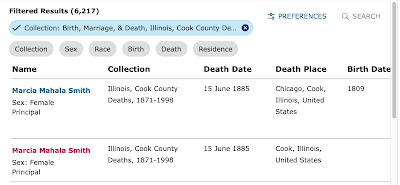What she knew:
- Her husband's ancestor's family was in Chicago in 1868.
- One of the family's children was baptized at Holy Family in 1873.
- The mother was listed in the 1880 New York census as a widow.
- When did the father die?
- When did the family return to New York?
I called the Archives and made an appointment to visit. (Hours and FAQs) It was an easy trip on the Red Line. I got off at the Loyola stop, crossed the street to campus, and walked toward the lake. The sidewalk wound between a number of buildings and easily led to the Cudahy Library. I showed identification, signed in, and made my way to the archives room where I was met by an associate archivist. She was friendly and welcoming and went out of her way to help me access the records I was there to use.
The Holy Family Parish School Tuition Records were kept in large bound ledgers and although the bindings were somewhat fragile, the pages were sturdy and easy to use.
Entries included the following information:
- When Received (I'm not sure what this date means. On the example page, that date is given as "November 20" for the first entry but tuition is only recorded for March through June.)
- Name (the child's name)
- Age (the child's age)
- Parents (usually the first name of a father)
- Residence (the family's street address)
- Rate per Month (this seemed to vary from 0 - $1.00 on the example page I copied; older children seemed to pay more; some children don't appear to have been charged)
- Months (August through July in separate columns)
- Room (class assignment)
- Fuel (blank on the example page I copied)
The books are divided into sections by first letter of surname, but entries are chronological, not alphabetical. As I read through each year looking for the researcher's family names, I noticed that many children returned year after year and children from the same family were usually entered together. These records could be used to track a family's address. The could also be used to approximate the birth dates of children in a family.
I'll include two example images below so that you can get a feel for what the records are like.
So, was the search of use to the researcher? I think so. I was able to find one entry listing two of the family's children and from it the researcher learned that the family was still in Chicago in 1874, living at a previously-unknown address. The children were received in April but they paid no tuition, so it wasn't possible to determine when they might have left the school.
I really liked the researcher's resourcefulness in trying to answer a hard-to-answer question. If you know of any other off-the-radar Chicago records that could be used in similar ways, please post a comment and share.
_______________
A kind reader shared a link to a Finding Aid for Holy Family Records. Follow the link to learn about the records that are available at the Archives.













